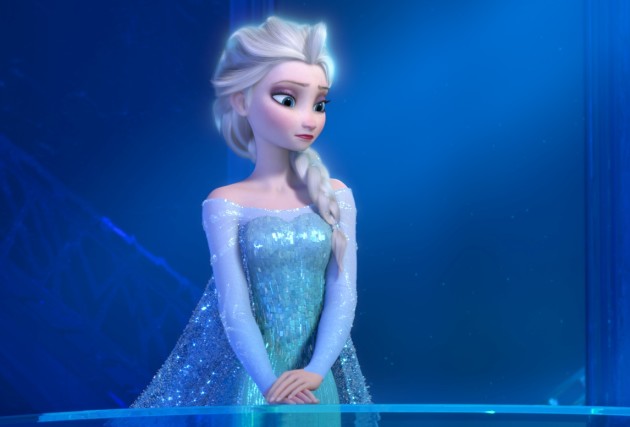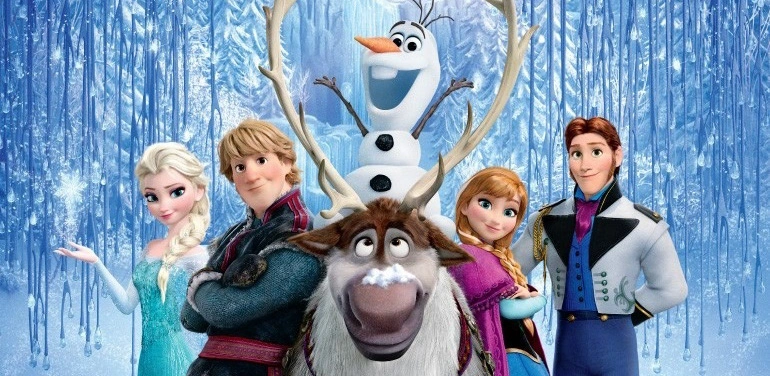Don’t let them in, don’t let them see
Be the good girl you always have to be
Conceal, don’t feel, don’t let them know
Well, now they know.– Queen Elsa, “Let It Go” – Disney’s Frozen
Last night I saw Frozen, Disney’s adaptation of Hans Christian Andersen’s classic fairy tale entitled The Snow Queen. After seeing the film, my friend Katie pointed out that this movie is perhaps signaling another Disney renaissance, a period characterized not only by the adaptation of well-known tales, but also by an increased public interest in Disney films. I couldn’t agree more with Katie’s assessment–Frozen contained a sense of depth and heart that many recent Disney films lack. Something that I immediately thought about when leaving the movie theater was that Frozen is perhaps the queerest animated film ever produced by Disney–queer being a theoretical practice centered on the deconstruction of binaristic thinking (i.e. visualizing gray areas in between the black and the white), a rethinking of what constitutes and upholds normativity (especially in terms of identity), and even more so, and the disruption of unnecessary regulations that prevent people from achieving a livable life. I’m not the only one who approaches this film as queer. Fellow blogger beautifulCHAOS, for instance, has written a delightful and insightful post on Frozen as a gay allegory (click here or here for other blogs that discuss this interpretation). I intend to further add to this conversation by distilling the film through the lens of queer theory.
Queen Elsa is approached by some viewers as a queer or gay character, not only because she doesn’t engage in a romantic relationship in the film, but also because she is forced by her parents to suppress and hide the powers that she is born with. Although the movie implies that her parents desperately try to conceal Elsa’s powers because of the danger that they impose to herself and to others, this does not justify the degree to which they prevent Elsa from having any human contact whatsoever. Furthermore, the fact that Elsa’s parents view suppression and isolation as solutions further emphasizes notions of the infamous queer closet–rather than assisting Elsa in learning how to hone her powers, they teach her how to “conceal, not feel.” I think it’s also worthy to point out that Elsa’s treatment is also eerily reminiscent of practices that take place during the process of gay conversion therapy, in which subjects are conditioned through meditative and repetitive processes to suppress certain urges and desires that occur naturally.

Although at first, a queer reading of Frozen seems slightly far-fetched, there are many events within the film that can be read as such with a little theoretical help. For instance, Judith Halberstam, in her book entitled The Queer Art of Failure, focuses significant attention on CGI animation movies to illustrate how they exemplify topics such as revolution and transformation that deviate from normative expectations of identity and linearity. Halberstam goes as far as to argue that revolutionary CGI animation movies (which she refers to as Pixarvolt films) depict a world where the “little guys” are able to overcome obstacles, and where they are able to revolt against the “business world of the father and the domestic sphere of the mother” (47).
Halberstam’s claims help to shed light on a queer interpretation of Frozen, especially when it comes to the role that failure plays in envisioning alternative modes of living and existing in the world. Although the fact that Elsa is forced to suppress her powers can partly be attributed to the danger that her powers pose on others, it is uncanny that the main enforcers of Elsa’s suppression are her parents–authority figures that try their best to uphold an image of normalcy by shutting Elsa away from the outside world. It is here that the film’s greatest binary manifests: the castle represents the “safe,” domestic, and feminine sphere, whereas the outside world is treacherous, threatening, and masculine. While locked within the confines of the domestic, Elsa is not only prevented from establishing meaningful relationships with other people, but she is also forced to regulate her powers even though she recognizes that this regulation is futile. After Elsa’s parents die, Elsa is expected to take over the crown. Although she tries to conceal her powers during her coronation ceremony–Anna’s provocation leads her to create ice in front of all the guests at the ceremony, inadvertently leading her to “come out” in front of the entire kingdom.
In The Queer Art of Failure, Halberstam points out how failure is a crucial process when it comes to the existence and survival of queer individuals, mostly because failure pushes people to explore alternatives when it comes to identifying ways to exist in the world. Elsa’s so-called failure to suppress her powers may have been a catalyst for many negative events; however, this failure influences her to escape the confines of the castle to let her non-normative identity thrive. Halberstam argues that breaking away from family and forgetting family lineage becomes a way of starting fresh even though it entails a failure from engaging in the heteronormative enterprise of the nuclear family. Thus, although Elsa’s escape from the castle and her creation of an ice-queendom up in the mountains can be approached as a renunciation of her expectations as a ruler and as an upholder of the domestic sphere, it also becomes an opportunity for Elsa to realize not only who she is, but just how much she is capable of doing and creating.
After Elsa discovers and unleashes her “queer” identity, she is able to collapse the binaries that have regulated and haunted her life. Notice that once she returns to Arendelle after embracing her powers, she declares that the gates of the castle shall stay open to the entire community, thus obliterating the divide that was being upheld between the domesticity of the castle and the queerness of the outside world. Even the castle itself begins to refute binaristic thinking at the end of the film as Elsa decorates the premises with ice-fountains, ice-sculptures, and ice-covered structures. Rather than presenting a world that is either hot or cold, the castle becomes a structure in which the frozen and the non-frozen coexist–ultimately eradicating the difference between the two.
A queer presence is ultimately what facilitates a more open and cooperative living situation to manifest–a living situation that allows all identities to exist without restrictions or unnecessary regulations. This echoes Judith Butler’s views on what she considers to be the goal of queer theory: rather than simply being a practice for obliterating normativity, it is a practice that should be aimed in opposition to “the unwanted legislation of identity” (7). Thus, queer theory does not aim to show non-normativity as a superior choice, but rather, it aims to show how normativity should not restrict what a person can or can’t be.

I can go on and on about how this movie invites the viewer to collapse the dichotomous views that are often ingrained within our collective consciousness. Frozen presents a world in which snowmen can exist during the summer, a world that blurs the distinction between living and non-living creatures (snow and rocks become animated characters with personalities), a world where animals are given a voice and where people speak on behalf of the animals, a world in which marriage is not viewed as the highest aspiration that a woman should have, a world in which even gorgeous characters are capable of being evil. If Frozen is pointing us toward a new direction that Disney is steering towards, then I think we will continue to see more brilliant films that are not only entertaining, but that are socially and politically conscientious (without necessarily shoving a message down our throats, as in the case of other animated films like Happy Feet). If Frozen is marking the beginning of a queer future for Disney, then it is a bright future indeed. As Queen Elsa affirms in the song Let It Go: “Let the storm rage on.”
Works Cited and Consulted
Butler, Judith. Undoing Gender. New York: Routledge, 2004. Print.
Frozen. Dir. Chris Buck and Jennifer Lee. Perf. Kristen Bell, Idina Menzel, Jonathan Groff, Josh Gad, and Santino Fontana. Disney, 2013. Film.
Halberstam, Judith. The Queer Art of Failure. Durham: Duke University Press, 2011. Print.


SUCH a great read! Well done!
Thanks! 🙂 I absolutely LOVED your post as well!
Reblogged this on daiong and commented:
I’ve found that interpreting Disney’s Frozen as a gay allegory makes sense to me after all.